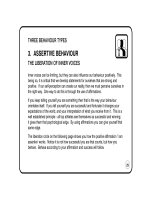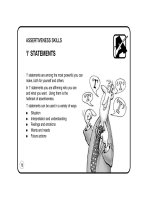THE CHALLENGERS POCKET BOOK phần 8 potx
Bạn đang xem bản rút gọn của tài liệu. Xem và tải ngay bản đầy đủ của tài liệu tại đây (68.31 KB, 10 trang )
71
TECHNIQUES AND TACTICS
ACTION REPLY
As with action REPLAYS on television, this is a 'one more time' technique.
When faced with certain challenging interventions, you use the question or remark as an
opportunity for a practical exercise - especially if there is no easy answer.
● Organise an instant role play or case study.
Example:
'Mmm, that's an interesting question. Let's try and act this one out. Why don't you
(challenger) play the role of X and you (another participant) the role of Y and let's
see how it goes?'
● Break into discussion groups to debate the topic.
● Create a plenary case study out of the question.
TECHNIQUES AND TACTICS
AGREE/DISAGREE/DEFLECT
When you disagree with a participant's remarks or arguments but don't wish to
embarrass them, first:
● Find SOMETHING about the contribution with which to agree.
Then:
● Gently disagree with the key issue.
Lastly:
● Deflect to the group for comment.
Example:
'Yes, you are absolutely right that this situation is extremely common. I'm not sure that
this is the only way to handle it however. Has anyone else found another way to deal
with it?'
72
TECHNIQUES AND TACTICS
BLOCKBUSTING
Asking closed, specific questions to cut through vague or abstract contributions. Use
participant's OWN words.
● Which, when, where, what, who specifically?
● How many, how far, how often, how old, how soon…. exactly?
● Everybody? Always? None? All of them? Etc.
● Compared to what? (Following a vague generalisation).
● What are you using as evidence?
Example:
Participant: 'Well, it's a question of bad communication really, isn't it?'
Leader: 'Sorry, which bad communication exactly?'
Participant: 'Well, people don't talk to each other, do they?'
Leader: 'I know what you mean, but what are you using as evidence that people
don't talk to each other?'
Participant: 'Well, only the other day '
73
TECHNIQUES AND TACTICS
BUILDING
Quite simply BUILDING on what a participant has said by adding something to show
how their contribution fits into the construction of the learning point.
Example:
Participant: 'I think it's important to praise people when they perform well. It
motivates them.'
Leader: 'Absolutely! That's one of the guiding principles of our system. And
when people are motivated they are much more open to bear
constructive criticism - to discuss how they can improve.'
74
TECHNIQUES AND TACTICS
CONFRONTATION
Sometimes, the best way to handle a challenger is to go straight to the point and
address the unwanted behaviour.
Examples:
● 'Could I ask you to abide by the no-smoking rule?'
● 'Sorry to interrupt you, Fred, but could we hear from someone from the sales
department on this one?'
More usually, confrontation is a last resort technique to be used one-on-one during a
break. Take the challenger to one side and specify simply and honestly the behaviour
you wish him/her to change. Always look for a pay-off for them if they do change, but
accept that the only solution may be for them to leave the course or meeting.
75
TECHNIQUES AND TACTICS
NAMING
This is perhaps the most powerful technique for keeping participants' attention and
interest - but it needs mental agility and a good memory. There are basically two kinds
of naming:
Backtrack Naming
Refer to participants' names and to contributions they made earlier. For example: 'Sandy
mentioned a similar incident yesterday and Joe told us about how he handled a case.'
Example/Metaphor Naming
Use participants' names in your illustrations and metaphors. For example: 'Let's imagine
that Jessica wanted to key into this programme, how would she start?'
Naming is particularly useful for:
● Boosting participants' confidence.
● Pre-empting objections.
● Giving the spotlight to those who want it.
● Keeping boredom at bay.
76
77
TECHNIQUES AND TACTICS
NON-VERBAL
When 'words fail you' a non-verbal signal can be very
effective in handling participant interventions.
Examples:
● Hands up in mock surrender.
● Hands over ears as if it's all too much.
● Sideways glance to other participants as if
to say: 'We've got a right one here'.
● A culturally acceptable 'my foot' gesture
or mime.
● A mock and exaggerated frown to show
surprised disagreement (but 'please
convince me I'm wrong!').
● Eyebrows raised in mock surprise/horror.
TECHNIQUES AND TACTICS
PSYCHOLOGICAL JUDO
When faced with challenging behaviour you 'prescribe the symptoms' of that behaviour.
In other words you ask for MORE of the unhelpful behaviour but, at the same time, you
make it unattractive for the participant to continue. As in judo, when the barrier against
which the participant is pushing is taken away, they suddenly feel out in the open and
vulnerable and will direct their attacking energy on to something more helpful.
Example:
When a smoker is given a whistle to blow every time they feel you should interrupt the
course for their right to a smoke break, they rarely blow the whistle.
They now wish to demonstrate their willpower.
78
TECHNIQUES AND TACTICS
RECEIPT
The most basic and non-negotiable of all techniques.
Simply give a receipt for EVERY contribution made by ANY participant!
● Say thank you and mention their name.
● Rephrase to fit your teaching point. For example: 'OK, so you're saying that
Good!'
● Simply repeat the last phrase and ask for other comments.
79
TECHNIQUES AND TACTICS
REFLECT/DEFLECT
DEFINITION
Reflect/Deflect is the process name for a relatively classic method of dealing with
participant challenges.
The method consists of:
● Reflecting back to the challenger what you think you have heard.
● Deflecting to one, several or all of the other participants the responsibility of
responding to the new, clarified version of the challenge.
The technique is based on the mind-set that:
● You don't have to have all the answers.
● Participants generally want you to succeed and will 'rescue' you from aggression.
● It's THEIR course/meeting anyway!
80









